| 1 | Green whipsnake |
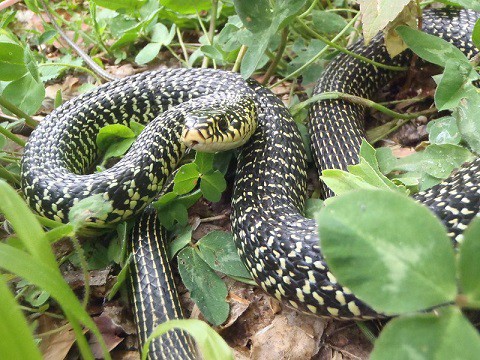
The most common snake in Italy, tied with the grass snake. The green whipsnake (Hierophis viridiflavus) is also one of Italy’s largest, at an average of 100-150cm, and a maximum of nearly 200cm. This species possesses the power of speed and agility, which it uses to escape most attackers with ease. They can reach 6.8mph, and will bite aggressively if cornered.
The green whipsnake inhabits virtually all of Italy, and moves by day. They’re not shy at all, and in warmer coastal areas of Italy, they can be active throughout the entire year, skipping hibernation entirely. There’s many colour variations within Italy, including fully black subpopulations in southern Italy and Sicily. This snakes belongs to the 3-member Hierophis genus, the other two members being the Balkan and Cyprus whipsnakes further east.
While green whipsnakes lack traditional front-fang venom, a victim who was chewed for 5 minutes straight began to show neurological problems. It transpires that they have a weak rear-fanged venom, similarly to the dice snake.
According to an Italian legend, if you find two green whipsnakes together, you should never say the words “il monaco con la monaca!”. Otherwise, the two snakes will look at you, and instantly charge in a murderous rampage. The phrase translates to “the monk with the nun!”.
| 2 | Aesculapian snake |
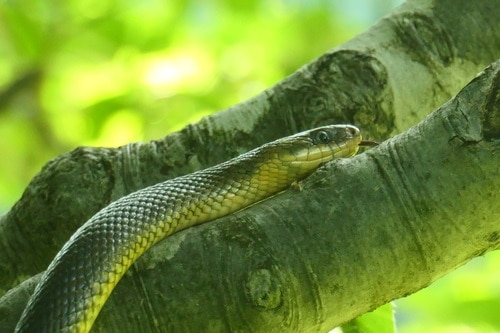
The master tree-climbing snake of Italy. Aesculapian snakes are mainly found in forests, including the darkest, gloomiest forests which other snakes won’t dare to venture to. They can effortlessly slither up vertical tree trunks, even without any branches to support them. This is a relatively elusive snake, which is sighted by ordinary Italians far less than the green whipsnake.
The Aesculapian snake (Zamenis longissimus) is completely non-venomous, and is drenched in ancient history. It was named after the Greek god of healing Asclepius, and was featured in the intricately carved rod he supposedly wielded for healing. 2000 years ago, there were many sacred healing temples featuring these serpents, where patients were made to sleep on a hard stone floor while Aesculapian snakes slithered over their bodies all night.
Aesculapian snakes regularly reach 1.5 metres, with an all-time record of 225cm (from Krems, Austria). Their diet mainly consists of mammals. In a thick forest near Oriola Romano, their single top prey species was found to be the bank vole, with the black rat ranking second. In a bushy pasture in the Tolfa Mountains near Rome, the house mouse was one of their favourites.
| 3 | Four-lined snake |
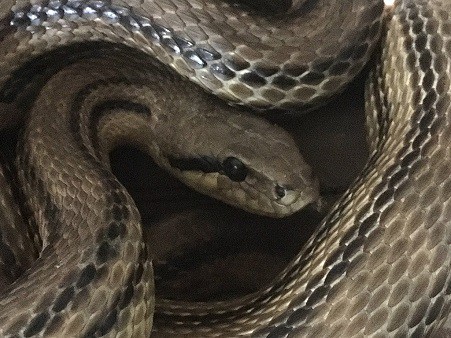
The official longest snake in Italy, with an all-time record of 250cm. Four-lined snakes (Elaphe quatuorlineata) inhabit the southern two thirds of Italy, and are closely related to the Japanese ratsnake far to the east.
This is a non-venomous species, and a particularly calm one even compared to most non-venomous snakes. Four-lined snakes rarely hiss or bite, preferring to stay still and let their camouflage do the work. They’re excellent tree climbers, skills they use for raiding birds’ nests.
Four-lined snakes appear in dense forests sometimes, but their real heartlands are open areas with an abundance of crumbling rocks, like old stone walls or natural slopes. You won’t find four-lined snakes in a park in central Rome, but you’ll definitely find them in the foundations of an old, abandoned farmhouse.
The diet of the four-lined snake is well documented, as we have a great study from Italy itself. In the Tolfa mountains outside Rome, its meals consisted of 77% mammals and 23% birds. The most common species was the woodmouse. But four-lined snakes also have the serpent superpower of eating eggs. They swallow these eggs whole, and crack them open in their own belly, using specially enlarged and sharpened vertebrae.
| 4 | Walser viper |
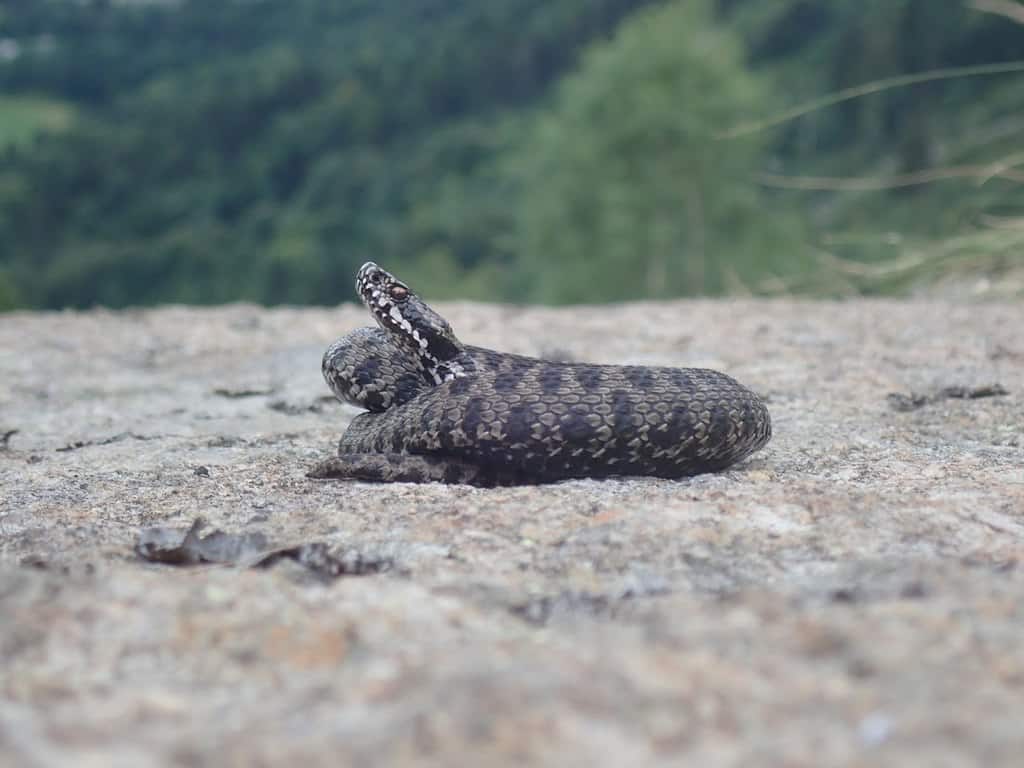
A venomous snake with one of the tiniest ranges in Europe. The Walser viper was long believed to be an adder subspecies, but separated into its own species (Vipera walser) in 2016. It lives exclusively in Piedmont, in a small mountainous area north of the Italian alpine town of Biella. There are two known populations, a northern one encompassing 45 square kilometres, and a southern population encompassing 225km². Walser’s vipers live at an average altitude of 1600 metres, and love to bask on warm rocks on their mountainous slopes.
Genetic analysis showed that this viper was most closely related to the Caucasus viper of Turkey. Despite a similar appearance, it was merely a distant cousin of the adder, and was closer to Italy’s meadow viper on the evolutionary tree.
Being such a recent discovery, there are no confirmed Walser viper bites on record, although they’ve almost certainly happened. The 2016 discovery study found a low genetic diversity, and recommended that they be listed as endangered.
With Europe so industrialised and fully explored, nobody expected to discover a new viper in 2016. It’s one thing finding a new kukri snake in an obscure Thai jungle cave, but finding a new species in Europe was extremely surprising. This is a relatively short viper, at an average of 35-60cm.
| 5 | Grass snake |
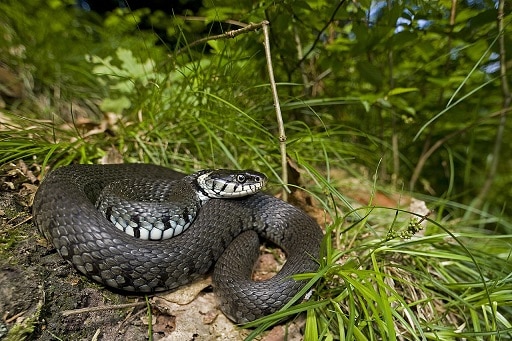
Europe’s most common snake, and an abundant snake all over Italy. Grass snakes aren’t fully aquatic, but are generally found near streams or ponds. They’re fantastic swimmers which zip along like speedboats, and are often spotted resting on floating lilypads. On land, they move more slowly, but with sudden bursts of speed if necessary. This is a non-venomous snake which defaults to playing dead for its survival, preferring deception over attack.
The grass snake is commonly found near villages, as its survival strategy involves laying eggs in warm compost heaps. With such a vast territory, the grass snake has different favourite meals by location. One study examined Marcigliana, in the Mediterranean region of central Italy. It found that mammals and amphibians were their favourite, and that the top two species were common toads (Bufo bufo) and the Savi’s pine vole (Microtus savii).
Italy has several grass snake subspecies, with the most interesting being Natrix natrix cetti. This lives exclusively on Sardinia, prefers watery environments, and sometimes has a bluish colour. This grass snake subspecies is typically 100cm, while the record for grass snakes as a whole is 205cm.
These days, the entire species is under confusion, as those in Italy may actually be the barred grass snake (Natrix helvetica), like the English and Welsh populations, which were also reassigned.
| 6 | Javelin boa |
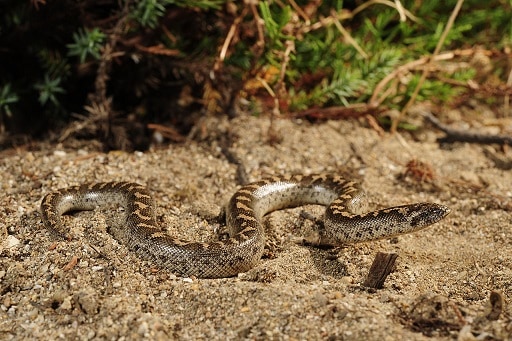
Probably the rarest snake in Italy. This 40-50cm constrictor (maximum 87cm) is closely related to the Arabian sand boa, and is short and thick with a stumpy tail.
The javelin boa is native to Turkey, Greece, southeast Europe and the Middle East, and hadn’t been sighted in Italy since the 1930s. That all changed in 2015, when both live and roadkilled javelin boas were officially confirmed in Licata, southern Sicily. Javelin boas inhabit nowhere else in Italy, just a tiny slice of this large southern island.
This species is notorious for Ancient Greeks hurling them towards their enemies as javelins in battle, to inspire panic and terror. Some believe that this inspired the name, but according to others, it comes from their signature hunting style. Javelin boas like to bury themselves in loose soil, and launch themselves upwards when prey pass, in an explosive display of speed.
Nobody is sure whether the javelin boa is native to Italy, or was introduced centuries ago by conquering Greeks. One study tested the Sicilian javelin boa population, and found a diet of 71.4% mammals by headcount. Reptiles and reptile eggs were also on the menu.
| 7 | Southern smooth snake |
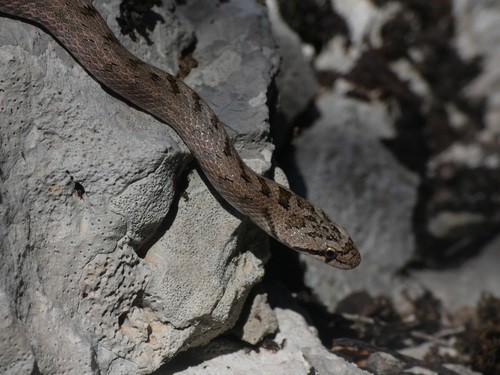
A shy and elusive snake. The southern smooth snake (Coronella girondica) has a maximum length of 96cm, though is usually significantly smaller. This is a non-venomous species, which instead survives by mimicking actual dangerous species in an elaborate routine. When cornered, the southern smooth snake presses its head against the ground, coils up, makes a snorting sound, then throws its head up as through preparing to bite.
Likewise, their pattern spacing is similar to the deadly asp viper (also found in Italy), a process called Batesian mimicry. Southern smooth snakes are found in the northern half of Italy, especially the northwest. They’re most common in open areas, including rocky plains, pastureland, plantations and Mediterranean shrubland. They also inhabit Spain and north Africa.
Southern smooth snakes have golden eyes, and are recognisable by a dark line stretching from each eye to the corners of their mouth. Most of their diet consists of reptiles, with their single favourite prey in Italy being the common wall lizard (Podarcis muralis). Compared to in Spain, the southern smooth snakes in Italy eat significantly more millipedes and centipedes.
| 8 | Leopard snake |
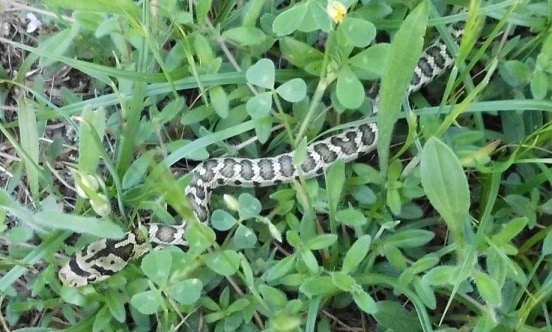
The leopard snake, AKA European ratsnake, is primarily a species of southeast Europe, particularly Greece. However, it has several natural outposts along the southeast coast of Italy, including in southeast Sicily and Puglia.
This Italian snake is one of the most comfortable in manmade environments. These include olive and citrus groves, parks, suburban gardens, and even towns. Leopard snakes (Zamenis situla) are even known to lurk discreetly in the historic old city parts of Catania. In the countryside, they prefer open areas like scrubland and coastal hilly areas.
This is a constrictor that mostly eats mammals, like the Aesculapian snake it is closely related to. At 70-100cm, and a maximum of 116-120cm, leopard snakes are far smaller than their cousin.
Leopard snakes have several morphs in Italy: a striped version, a patched version, and an in-between version. Originally, they were divided into subspecies based on these patterns, but recently, they were lumped together again. The leopard snake is just one single species with various superficial morphs, like the eyelash viper of Central America (a super variable species). The striped morph is particularly common along the Adriatic coast of Puglia.
| 9 | Dice snake |
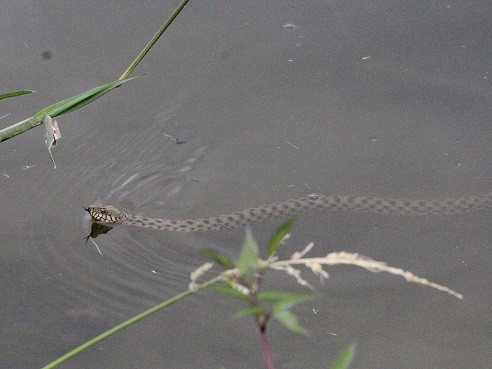
Italy’s fishiest snake. The dice snake (Natrix tessellata) is a relative of the grass snake, but even more water-dwelling. The dice snake can spend hours underwater in the slow-moving river habitats it favours, surfacing only to take a 2 second breath, before vanishing into the depths again. In optimal conditions, this species can swell to vast numbers, with thousands of dice snakes per lake.
Dice snakes measure 100-120cm, with a maximum of 130cm, and are most active in the afternoon. Compared to their cousin, they’re more much more heavily reliant on fish. In a stream called Fosso Verginese in a hilly region of central Italy, 97% of the dice snake’s meals were fish, compared to just 17% for grass snakes.
Dice snakes are highly reliant on vision for hunting, as scent molecules are dispersed and harder to track in water. Instead of using venom or constriction, dice snakes simply grab their prey and force them down. That prey doesn’t include human beings, as dice snakes almost never bite. Like the grass snake, they love to play dead, and they sometimes fill their own mouths with blood to add to the deception.
| 10 | Asp viper |

By far the most common venomous snake in Italy. Asp vipers range from 40cm to a maximum of 82cm, have a slightly upturned nose, and are most common in sheltered areas such as thickets and hedges. It’s estimated that this species causes 90% of fatal snakebites in Italy.
The asp viper has 5 subspecies across Europe, and Italy hosts 3, the main one being Vipera aspis francisciredi. This has a very swollen head compared to the French subspecies, particularly behind the eyes, as though somebody’s inflated them with a bicycle pump. Sicily meanwhile, hosts Vipera aspis hugyi, which has circular dark marks, while the far north is the realm of Vipera aspis astra, a version with unusually thick dark bars.
Another Italian statistic came from the Poison Control Centre of Milan, stating that 21% of dogs bitten by asp vipers didn’t survive. Despite this danger, asp vipers aren’t aggressive. They slither slowly, and will only turn nasty if you harass or pick them up.
In a study from the Tolfa mountains of central Italy, mammals comprised 81.4% of the asp viper’s diet. The top species were the common shrew (Sorex araneus) and house mouse (Mus musculus). This differs to France, where they’re largely vole addicts, sometimes at up to 90% of meals.
Further north in Italy, Vipera aspis astra was obsessed with the Savii’s pine vole. They also ate the lesser white-toothed shrew (Crocidura suaveolens), but in smaller quantities, despite being more common locally. The asp vipers ignored two other small mammals which were easily available: the wood mouse and striped field mouse.
